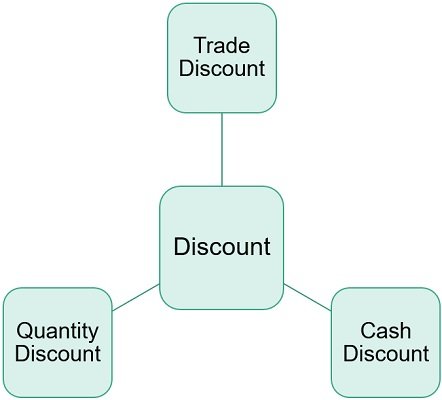Definition: Discount implies a concession or deduction allowed at a specified rate from the price of the goods given by the seller to the buyer or by the creditor to the debtor. It is given to lure customers and promote sales. The amount of discount must be received or paid with regard to the terms of the sales agreement. Here, it is to be noted that discount is always calculated on the marked price of the item.
On the application of the discount, the receiver of the sum gets a reduced amount than the sum actually due to be paid. Conversely, the payer of the sum has to pay a smaller sum than was actually due for payment. That is to say, a discount results in a loss to the receiver, but profit to the person who has to pay.
Types of Discount
There are three main types of discount, discussed hereunder:
Trade Discount
A deduction from the given list price is regarded as a trade discount. It is provided by the manufacturer or wholesaler to the retailer, on the retail price of the product. It indicates the profit margins of the reseller, as the reseller sells the product to the final consumer at retail price. Further, they are subtracted as a part of the initial sale, they are not sales discounts.
This is provided to increase the sales volume. Further, it is given as a percentage of the listed price. Once this discount is given, the net sale price or net amount which the customer has to pay will be calculated. Further, no recording of such discount is made in the books of accounts. That is to say, transactions are recorded at their net sales value.
Cash Discount
In this, the deduction from the price is made when a cash payment is made. This is provided to the customers to increase prompt payment and flow of cash. It is provided to the customer when he makes payment on time before the due date. Calculation of this type of discount is given as a percentage based on the total amount payable.
Credit terms printed on the sales invoice generally include: Goods billed are subject to cash discount @ (percentage), if paid within ten days, else full amount will be charged.
Quantity Discount
Another name for quantity discount is a volume-based discount. A discount provided to the customer from the list or catalog price, for making purchases in bulk, it is called quantity discount. It is given to encourage the purchase of goods in bulk. So, the recording of purchase is done at the net purchase price. Plus, no separate account is created to record quantity or volume-based discounts.
Calculation of discount
To calculate the cost of the article after discount, when the discount is given as a rate on the listed price, you need to write the percent as a fraction and multiply it with the price. The result obtained will be subtracted from the original price of the goods.
What is Successive Discount
Series of discounts offered to the customers are called successive discounts. In case when successive discounts are given, the first discount is deducted from the marked price, to arrive at the net price after giving the first discount.
The price calculated is considered as the new marked price, and then the second discount is calculated on the new marked price, then the resultant sum is subtracted from the new marked price to get the net price after the second discount. This process is continued to reach the net selling price.
A word from Business Jargons
To survive and beat the ever-increasing competition in the market, business enterprises offer discounts to their customers with an aim of boosting the sale of goods.

Leave a Reply